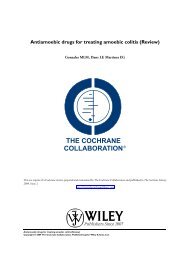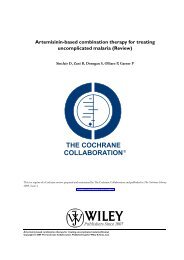Topical treatments for fungal infections of the skin and nails of the foot.
Topical treatments for fungal infections of the skin and nails of the foot.
Topical treatments for fungal infections of the skin and nails of the foot.
You also want an ePaper? Increase the reach of your titles
YUMPU automatically turns print PDFs into web optimized ePapers that Google loves.
0.68; Analysis 3.1).<br />
Undecanoates<br />
A placebo controlled trial <strong>of</strong> undecanoates (n = 168, Chretien<br />
1980) also showed a statistically significant effect with relative<br />
reduction in treatment failure at 2 weeks <strong>of</strong> 86% (RR 0.14, 95%<br />
CI 0.06 to 0.31; Analysis 3.1).<br />
Medium-term outcome (six weeks)<br />
Butenafine<br />
A statistically significant effect <strong>of</strong> butenafine(1%) was observed<br />
when it was used <strong>for</strong> 1 week <strong>and</strong> <strong>for</strong> 4 weeks. Butenafine used<br />
<strong>for</strong> 1 week versus placebo was evaluated (n = 271) in one trial (<br />
Savin 1997). A statistically significant relative reduction in treatment<br />
failure <strong>of</strong> 67% was observed (RR 0.33, 95% CI 0.24 to<br />
0.45; Analysis 3.2). Butenafine used <strong>for</strong> 4 weeks versus placebo<br />
was evaluated (n = 80) in ano<strong>the</strong>r trial (Tschen 1997), giving a statistically<br />
significant relative reduction in treatment failure <strong>of</strong> 81%<br />
(RR 0.19, 95% CI 0.08 to 0.43; Analysis 3.2). Nei<strong>the</strong>r <strong>of</strong> <strong>the</strong>se<br />
trials achieved at least 80% follow-up.<br />
Ciclopiroxolamine<br />
Ciclopiroxolamine (1% <strong>and</strong> 0.77%) used <strong>for</strong> 4 weeks was evaluated<br />
in 2 placebo controlled trials (n = 144, Kligman 1985a; n<br />
= 317, Aly 2003). A statistically significant relative reduction in<br />
treatment failure was observed (RR <strong>of</strong> treatment failure = 0.27,<br />
95% CI 0.11 to 0.66; Analysis 3.2).<br />
Tee tree oil<br />
Tea tree oil (10%) used <strong>for</strong> 4 weeks was evaluated in 2 placebo<br />
controlled trials (n = 185, Satchell 2002; Tong 1992). Although<br />
one <strong>of</strong> <strong>the</strong> individual trials showed a statistically significant effect<br />
(Satchell 2002), <strong>the</strong> results <strong>of</strong> <strong>the</strong> second trial were less favourable,<br />
<strong>and</strong> combining data from both trials did not show a statistically<br />
significant effect (RR <strong>of</strong> treatment failure 0.73, 95% CI 0.48 to<br />
1.11;Analysis 3.2). Only <strong>the</strong> trial with <strong>the</strong> less favourable results (<br />
Tong 1992) had at least 80% follow-up.<br />
Tolciclate<br />
Tolciclate (1%) used <strong>for</strong> 6 weeks was evaluated in a small placebo<br />
controlled trial (n=40, Gomez 1986) <strong>and</strong> produced a relative reduction<br />
<strong>of</strong> treatment failure <strong>of</strong> 0.04 (95% CI 0.00 to 0.63; Analysis<br />
3.2), a statistically significant effect, with at least 80% follow-up.<br />
Tolnaftate<br />
Tolnaftate (1%) used <strong>for</strong> 4 weeks was compared with placebo<br />
in 2 trials (n = 115, Fuerst 1980; Tong 1992) <strong>and</strong> a statistically<br />
significant relative reduction in treatment failure <strong>of</strong> 70% was found<br />
(RR 0.30, 95% CI 0.13 to 0.72; Analysis 3.2), with at least 80%<br />
follow-up in both trials.<br />
Undecanoates<br />
Undecanoates (Undecylenic acid, zinc undecylenic acid) were<br />
compared with placebo in two trials (n = 125, Chretien 1980;<br />
Fuerst 1980) <strong>and</strong> a statistically significant relative reduction in<br />
treatment failure <strong>of</strong> 71% was found (RR 0.29, 95% CI 0.12 to<br />
<strong>Topical</strong> <strong>treatments</strong> <strong>for</strong> <strong>fungal</strong> <strong>infections</strong> <strong>of</strong> <strong>the</strong> <strong>skin</strong> <strong>and</strong> <strong>nails</strong> <strong>of</strong> <strong>the</strong> <strong>foot</strong>. (Review)<br />
Copyright © 2009 The Cochrane Collaboration. Published by John Wiley & Sons, Ltd.<br />
0.70; Analysis 3.2), with at least 80% follow-up in both trials.<br />
(ii) Treatment versus treatment comparisons<br />
Comparisons between Different Allylamines or Allylamine<br />
Regimens<br />
Four trials compared <strong>the</strong> rate <strong>of</strong> treatment failure <strong>of</strong> different allylamines<br />
or allylamine regimens (all 1%, Ablon 1986; Bergstresser<br />
1993; Evans 1994; Smith 1990b).<br />
Short-term outcome (two weeks)<br />
Naftifine twice daily<br />
In <strong>the</strong> trial by Smith 1990b (n = 117) no statistically significant<br />
difference was observed at 2 weeks between naftifine used once<br />
daily or twice daily (RR <strong>of</strong> treatment failure at 2 weeks 0.92, 95%<br />
CI 0.72 to 1.17; Analysis 4.1).<br />
Naftifine versus terbinafine<br />
In <strong>the</strong> evaluation <strong>of</strong> naftifine compared with terbinafine (n = 62,<br />
Ablon 1996) <strong>the</strong>re were similar treatment failure rates at 2 weeks<br />
<strong>for</strong> each <strong>of</strong> <strong>the</strong> 2 <strong>treatments</strong> (RR <strong>of</strong> treatment failure 0.98, 95%<br />
CI 0.69 to 1.41; Analysis 4.1).<br />
Medium-term outcome (six weeks)<br />
Naftifine twice daily versus naftifine once daily<br />
Smith 1990b compared 1% naftifine once daily to twice daily both<br />
<strong>for</strong> 4 weeks (n = 101) <strong>and</strong> found fewer treatment failures with<br />
twice daily, thought <strong>the</strong> difference was not statistically significant<br />
(RR <strong>of</strong> treatment failure = 1.74, 95% CI 0.82 to 3.67; Analysis<br />
4.2).<br />
Naftifine versus Terbinafine<br />
Ablon 1996 compared naftifine with 1% terbinafine, both applied<br />
<strong>for</strong> 2 weeks (n = 62), <strong>the</strong> results favoured terbinafine but <strong>the</strong> difference<br />
was not statistically significant (RR <strong>of</strong> treatment failure<br />
2.05, 95% CI 0.77 to 5.42; Analysis 4.2). Evans 1994 compared<br />
terbinafine applied <strong>for</strong> 5 to 7 days with terbinafine applied <strong>for</strong> 1<br />
to 2 days (n = 65), no statistical difference was detected in <strong>the</strong><br />
treatment failure rates (RR <strong>of</strong> treatment failure 0.89, 95% CI 0.31<br />
to 2.50; Analysis 4.2).<br />
Terbinafine four week versus terbinafine one week<br />
Bergstresser 1993 compared terbinafine used <strong>for</strong> 4 weeks with<br />
terbinafine used <strong>for</strong> 1 week (n = 83) but also did not detect any<br />
difference between <strong>the</strong> rate <strong>of</strong> treatment failure in <strong>the</strong> 2 groups<br />
(RR <strong>of</strong> treatment failure 1.06, 95% CI 0.42 to 2.66; Analysis 4.2).<br />
All <strong>of</strong> <strong>the</strong>se results are based on at least 80% follow-up except those<br />
<strong>of</strong> Bergstresser 1993.<br />
11








